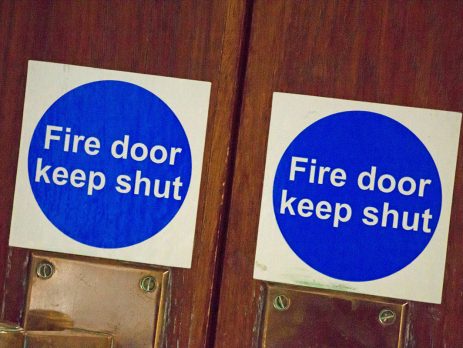How to check fire doors?
Reading Time – Approx. 3.5 Mins
What is a fire door?
A fire door provides not just a means of escape from a fire within a building, such as an office, but acts as a barrier against fire from spreading from one room to another protecting the contents and the rest of the building as well as nearby buildings.
A properly fitted and maintained fire door can stop and prevent fire and smoke from spreading, by containing it within a fire compartment for 30 minutes, and in some cases up to an hour. They are an integral part of any building’s passive fire safety plan.
As part of a fire safety plan, doors should be signed and marked whether:
- It should be kept closed when it is not in use
- Should be kept locked when not in use
- Are to be held open using an automatic release mechanism
What is a fire door composed of?
As a fire door is a specially engineered safety device it is composed differently from a standard door. Most fire doors are thicker than a standard door with most having a solid core (some manufacturers do produce hollow core doors).
In every groove of the door, intumescent seals are fitted, which when exposed to the heat of a fire, expands and seals the gap between the door and frame.
How Long Do Fire Doors Last?
Fire doors are normally tested to last to hold fire back in a fire compartment for 30 minutes or 60 minutes, provided they are installed correctly. The top edge of the door is usually where the certification of the fire door can be found, identifying if the door is rated FD30 (30mins) or FD60 (60mins)
A fire door is only effective if the door is closed – and all doors should have a self-closing device, which a competent fire door inspector should check is fully functioning.
Fire doors that are subject to regular use could deteriorate over time and require regular inspections to remain both compliant and well maintained.
Hydro-x Training is the main provider of Fire Door Inspection courses in the UK and it is accredited by City and Guilds. Contact us about your On-Site or Virtual training requirements.

Reasons why we inspect fire doors
As fire doors are an integral part of a fire safety plan, with their primary purpose being to save lives and offer protection to buildings and their contents they must be fitted correctly and regularly inspected for any defects and maintenance purposes.
Any slight damage or changes to the door can affect how it works or operates during a fire, with fire resistance being compromised. Fire door inspections can highlight if there are large gaps between the leaves and the frame or if the door has been correctly installed.
As inspecting fire doors is a legal requirement, using a trained and competent person is a must. This can be achieved by City and Guilds Accredited Fire Door Inspection course by Hydro-x Training.
Are inspections a legal requirement?
It is a legal requirement that fire doors are routinely inspected and maintained as any change or damage that it sustains can affect its effectiveness should a fire break out.
Under The Regulatory Reform (Fire Safety) Order 2005, it states that the Responsible Person is to make sure the fire doors and escape routes are correctly maintained and installed. Article 17 Fire Safety Order 2005. The Responsible Person must employ a competent person to carry out these checks at least every 3 months, or more often in high-traffic areas including hospitals and schools. Our Fire Door Training courses cover all the legal requirements and correct procedures to test and maintain Fire Doors.
An inspection should include:
A fire door inspection should follow the recommendation set down in BS 9999
| Frequency | What to do |
| Daily | Automatic release mechanisms are ‘test released’ |
| Monthly | Doors held open with automatic devices should be tested with a simulated power failure, fire detector or fire alarm activation |
| Three Monthly | As daily and monthly above |
| Six Monthly | Check smoke seals are undamaged and there is no structural damage to the door. Check the gaps are not too small or large for effective smoke sealing. Opening and closing devices are operating correctly. |
| Annually | As all the above |
What is a Fire Risk Assessment?
It is beneficently, whilst it is not a legal requirement, that Fire Door Inspectors have a working knowledge of general Fire Safety Risk Assessment.
Fire risk assessments include, under Government guidelines, these five steps:
- Identifying fire hazards
- Identifying people at risk
- Evaluate, remove or reduce any risks
- Record your findings, prepare an emergency plan and provide training
- Review and update the fire risk assessment regularly
Fire Door Inspection Course with HX Training
This article has given a brief overview on fire safety and fire door safety. To get a full overview and to gain the skills to be able to inspect a fire door, Hydro-X training offers a City and Guilds Accredited training course that can be completed to suit your business – whether it’s On-Site training or Virtual training. All courses come complete with all the materials and expert knowledge from our experienced trainers.
For more information, or to book one of the courses available, either visit our detailed course page at Hydro-X or contact us to speak to a member of the team.



